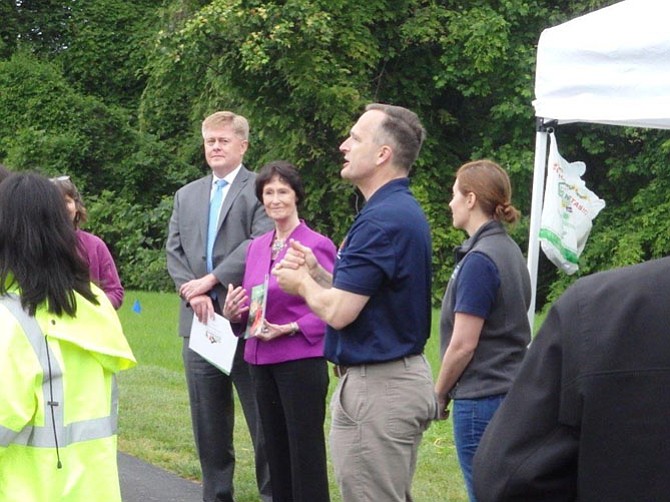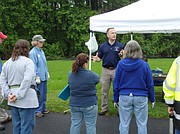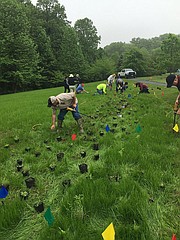Charles Smith, branch chief with the Stormwater Planning Division in the Department of Public Works, with Board of Supervisors Chairman Sharon Bulova and Braddock District Supervisor John Cook at the planting of the pollinator meadow located adjacent to the Fairfax County Government Center. Photo contributed
Some 40 volunteers planted a pollinator meadow for two days last week on one acre of land adjacent to the Fairfax County Government Center in Fairfax. The volunteers from the Northern Virginia Soil and Water Conservation District planted about 2,000 plants (from 48 different species) -- using about one-third grasses and two-thirds wild flowers. These are native plants with deep roots that attract bees and butterflies and help retain the stormwater from going into the nearby stream in the woods.
"Planting this pollinator helps the stormwater runoff to not reach the stream," said Irene Haske, an information officer with the Fairfax County Department of Public Works and Environmental Services. "The water will percolate down into the water table and it gets cleaned as it goes down further into the earth. It will help prevent runoff and erosion."
She added: "When the sediment flows off the land, it buries the little critters; and they're an important part of the ecosystem.... It's not just saving the butterflies; it's aesthetically pleasing as well."
The project is being divided into four phases over several months: planting seedlings, planting plants that provide color and structure (last week's efforts), providing invasive controls (to be done by a contractor over the summer), and planting woody shrubs (next fall) to improve the edge condition with native trees and shrubs.
AT A COST of $3,500 for the project, the county purchased plants at Earth Sangha, a local nursery that works in the spirit of the Buddhist practice by propagating native plants from locally-gathered seeds. The county purchased native warm season grasses to hold the soil in place; including little blue stems, purple love grass, flowering liatris, asters and New York ironweed, among others. The cost included soil preparation and removal of invasive vines that were hanging on nearby trees, to be replaced with native edge plantings such as silky dogwood, pawpaw, chokeberry and redbuds. The edge plantings help fill the gaps between the meadow and the mature forest canopy nearby.
"What we're trying to do is offer a number of seasons for blooming," said Charles Smith, branch chief with the Stormwater Planning Division in the Department of Public Works.
He said with the meadow next to the forest, it provides critical habitat for many of the pollinators during the year. "You have to have that landscape mosaic to support the full cycle of the insects," he said, adding that periodic mowing twice a year prevents woody plants from coming in, recycles nutrients, and also promotes seed germination and plant growth.
"The insects don't just pollinate the plants; they also eat them," he said. "The predators eat the insects, and by the insects eating the plants, they are transferring the energy to the rest of the food chain to birds, lizards and small mammals."
Laura Grape, executive director of the Northern Virginia Soil and Water Conservation District, added: "We are really excited about this project because it shows Fairfax County's commitment to enhancing the community's shared assets in a way that also enhances our natural community assets."
She added: "I think this is going to be a point of inspiration to a number of county residents and businesses alike; those that are interested in enhancing their own properties in an environmentally conscious and beautiful way."
She said between Thursday's and Saturday's events, they've had 40 volunteers join in this partnership to enhance this portion of the Fairfax County Government Center property. "There have been volunteers of all ages that are actively planting this great meadow and also learning about what it can do to enhance the pollinator community and also enhance the aesthetics of an area."
THE VOLUNTEERS planted containerized plants; the seeds of which can take 18 months to germinate. By planting plants that develop roots that are 12 to 36 inches deep, Suzy Foster, Landscape Architect III, said they help control runoff water from this site into the Chesapeake Bay. "We have to reduce sediment in our streams and channels. We do that in a variety of ways. This is infiltrating stormwater runoff as soon as it hits this meadow."
She added: "We're creating a living sponge that will absorb more water than a typical lawn. We're improving the sponge-ability of the soil and reducing the maintenance because we're cutting down on mowing."
Foster said homeowners can follow the lead and convert their own 8x8 or 10x10 lawn properties into native plants to help promote native insects and birds. "The real message is to plant native plants like butterfly weed, blazing star and black-eyed Susans and native oak and cherry trees to promote the insects, native mammals and birds," she added. "If you could choose one plant, plant an oak tree; it supports more species of native insects than any other tree in the area."
And she said by planting native plants, it helps support the native fauna, which includes everything from insects to deer.


